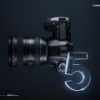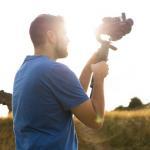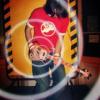Leaderboard
Popular Content
Showing content with the highest reputation on 04/13/2013 in all areas
-
@Rungunshoot Before buying any of those (around $500 price range), I'd rather wait 'til they are produced by SLR magic or others (or abuse some of the cheaper or older lenses Andy listed). I expect the BM Pocket to be a bestseller, it will push MFT tremendously and people will demand wide angle lenses. Panasonic and the other MFT sellers say 'thanks BM'! Until then, there are two existing MFT lenses that allow a run&gun style (equaling 36mm, the classic reporter's focus length) and are fast enough to provide some shallow DoF, this is the SLR magic 12mm (originally an observation lens as well) and the Olympus 12mm (with the automatic functions working, I am curious to see the auto exposure work with the 13 stops and high iso). As for a standard lens, why not the Lumix pancake 14mm that's seen on the camera on the BM site? (EDIT: I know 50 mm is considered standard, but that's valid only for a 3:2 aspect ratio, it would be 47 mm for 16:9, 42 mm is a good compromise. You wouldn't shoot portrait close ups with it, but as far as portrait lenses are concerned, there are of course hundreds of options for MFT.) With the BM cameras, we will see another game changing. It will no longer be about 'as shallow a DoF as possible'. There is nothing special about that any more. It will start to be about image quality. We are not yet fully aware of the avalanche that has been triggered. Ordinary hobbyists will buy the BM Pocket for under $1000 (in Germany, you can order it for 894,88 €, that's almost 200 € less than the GH3, body only). They will be able, at least, to use Resolve lite 10 for free, which has more editing features than #9 and works platform independant (a very shy love relationship between BM and Apple has to be acknowledged though). They will be told that RAW as well as ProRes 422 10-bit provide better quality than their pathetic '16,7 million colors' display can handle. They will be convinced by the industry that their old displays don't suffice anymore. They will buy 10-bit monitors (a few years ago 5-10.000 bucks, now starting at ~500, allegedly Dell has some good and affordable models. BTW: This is a serious limitation for all iMac users. Their displays are 8-bit. Probably there is/will be a solution from BM, I don't know, BM says 'thank you Apple'). They will learn to see the higher quality (frankly, it's easier to see than the difference between, say, 720p and 1080p). This is what I call a change. EDIT: We can only speculate which lenses will be best for the Pocket. Sensor size, lens characteristics, post-debayering, we simply can't tell how these things influence each other. I really think it's wise to start with the most basic pancake and then collect experiences.2 points
-

BMPC 4K greenscreen "should" be keyable?
HurtinMinorKey reacted to mtheory for a topic
Correct, I meant to say "optical distortion" instead of "optical image" in that sentence. Those 4 center squares at the bottom are the sweet spot with least distortion, so an S35 will naturally take advantage of that. Question is, will it make much difference visually? Only the eye will tell, I have an old Canon 20D lying around with a 1.6x factor, will have to make my own test sometime.1 point -

Blackmagic Pocket Cinema Camera
dahlfors reacted to MattThomasFilm for a topic
On this NAB video - http://www.youtube.com/watch?v=gg0VZWRy1NI, the Blackmagic rep mentioned Class 10 cards but he didn't mention the speed, so maybe 30MB/s cards might work for ProRes? Edit. Just looking on the BlackMagic site and they picture 45MB/s card so I guess you were right about them being too slow. It might be more worth while getting an external recorder? But then you'd be losing the RAW option right? Unless there's a RAW external recorder?1 point -
Wesley 24mm f/1.4 - YES - pics to follow Cosmicar 25mm f/1.8 - YES - pics to follow Pentax 25mm f/1.4 - YES - pics to follow1 point
-
Super 16 Lenses for Pocket Cinema?
Ernesto Mantaras reacted to andy lee for a topic
Sigma EX 10-20mm F/4.0-5.6 is worth looking at I used this on the BMCC camera and it works well at the 2.3 crop of that camera so at 3x it will work well too - it does have some distortion at the edges but it is a very useful zoom range great outside in daylight with nds you dont mind that its not a fast lens then with a canon to micro 4/3 adaptor you can just use it wide open1 point -
Why Blackmagic will ship in July
tony wilson reacted to Axel for a topic
You are right and wrong at the same time. The death of Osama bin Laden in May 2011 was allegedly filmed, but nothing of this was ever shown to the public. The corpse was thrown into the ocean. There actually is no way to tell, no way to prove, that he actually was killed. But where are all the usual myths? Even Elvis, whose enormous corpse was not hidden after death, did survive for some. The reason is logic. If Osama was alive, the easiest way to put shame on his arch enemy was a short video in which he says, hi Barack, I'm as fresh as a daisy, na na-na na-naaa-na! And because Obama could'nt sleep with this scenario in mind, that's enough to prove he didn't lie. In this case, not being able to deliver in July would be suicidal for BM. The excuses of the past (we couldn't catch Osama because he was hidden so well) don't count now. This is not the hangdog attitude of someone who disappointed others, it is a swell announcement. So they have to be sure, they really think, that they can deliver as promised.1 point -

Super 16 Lenses for Pocket Cinema?
Julian reacted to Ernesto Mantaras for a topic
It'll be great to see that GH2 test you mentioned. Let us know once it's done!1 point -

BMPC 4K greenscreen "should" be keyable?
mtheory reacted to Sean Cunningham for a topic
They don't look "fine" they look distorted and it's just that some directors like that. They do not, however, look like what you get when you use a lens designed explicitly for close-up or portrait style photography. They are a choice (one would hope). There isn't an equivalency here. Using a wide angle lens for close-up is either a stylistic choice or a lazy/ignorant choice. If you don't make a choice at all, the result falls to the later. If you don't know why it's a choice, it falls to the later. But there is no equivalency here.1 point -

Best options for Slow Motions with Panasonic GH3?
Wit reacted to Joseph Moore for a topic
PS. Make sure you set your shutter speed at twice what you do for normal footage so that the motion blur ends-up looking the same.1 point -

Best options for Slow Motions with Panasonic GH3?
Wit reacted to Joseph Moore for a topic
Choosing to slow down in-camera is the same as choosing to shoot at 60/50 fps...the camera just automatically applies the metadata so that your NLE will play it back at 24fps. It's a convenience factor. In other words, if you shoot at 60 fps in camera, you have to slow it down 40% in your editor. If you shoot with the camera applying the 40% slow-down, it records the exact same number of frames, you just don't have to do any extra work after the fact. You definitely do *not* want to shoot interlaced. That's old info based on cameras that could only shoot 60i, not 60p. Whether you can mix formats on the timeline of your editor is up to the editor. Most modern editors such as Premiere, FCPX, etc. do allow this.1 point -
Sony seem to love making announcements about announcements, show us a product with a time frame or go home.1 point
-
Active image stabilization is great in the meantime. But imagine the MöVi or a similar device on a shot of this kind (starting 1:45 min): http://www.youtube.com/watch?v=sYFXv6bDIY8#t=1m45s Soy Cuba is from 1964 but still a classic with extraordinary shots.The camera was handheld and passed from one operator to another or connected to cablecam trollies ascending from street level, through the building and at the other side again on a cablecam and above the street. Thogether there were two flights with cablecam systems and the rig was connected with a magnet to the trollies for fast coupling. I would use carabiners for higher safety and together with my cablecam I can imagine to get something like this done. The stabilized third axis would also help on the cablecam to point the camera correctly and being stabilized like in the MöVi video. Here is some additional information about the movie: http://www.rogerdeakins.com/forum2/viewtopic.php?f=2&t=8501 point
